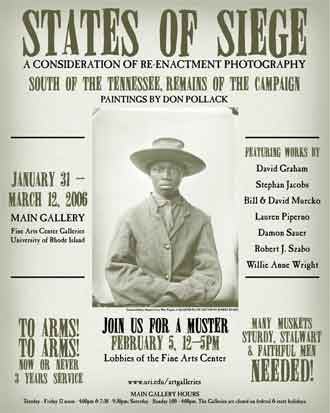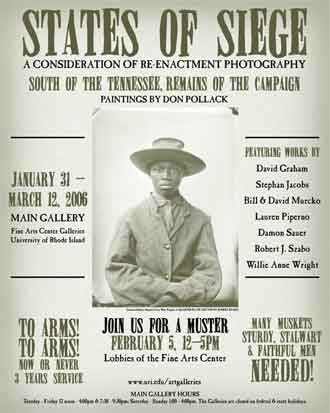 Stalwart families invited to muster at the URI Galleries, Feb. 5
Stalwart families invited to muster at the URI Galleries, Feb. 5
KINGSTON, R.I. — January 30, 2006 — While visits to art galleries are usually considered to be time for quiet reflection, these will take on a distinctly revolutionary air at the University of Rhode Island’s Fine Arts Center next month.
In fact, a special exhibition called “States of Siege: A Consideration of Re-enactment Photography,” will feature a complementary ‘Muster’ event complete with Civil War re-enactment troops, foods, music and more from the era. Free and open to the public, the event will take place on Sunday, Feb. 5, from 12 to 5 p.m.
The muster will complement the “States of Siege” Photography exhibition that includes “Remains of the Campaign” by acclaimed artist Don Pollack that runs Jan. 31 through March 12. Pollack’s landscape paintings remark on the historical immersion of photography as he paints sites of previously photographed areas from the Civil War campaign. His paintings identify photography’s “encoded conventions of nostalgia, narration, and documentation.”
The afternoon’s activities will start with the “Trooping of Colors” presented by the 14th Rhode Island Heavy Artillery Regiment. This is the state’s African-American Civil War Regiment, re-enacted by a dedicated group of students from Providence’s Central High School, under the leadership of Rob Goldman. A local fife and drum corps will accompany the troop.
The Regiment will be involved throughout the event, demonstrating various aspects of Civil War military life, including what soldiers of the 1860s typically ate. Hard tack and salt pork will be there to sample, as well as casseroles, puddings, cakes, and cookies of the Civil War era. A musket bayonet drill is also planned.
A group re-enacting “typical citizen-soldiers” of the Revolutionary War, the Glocester Light Infantry, will march in formation that afternoon. The unit was chartered in 1774, in response to increasing political tension with the British Crown. In addition, David Cunningham, an African-American re-enactor/interpreter, will represent the 1st Rhode Island Infantry Regiment, the country’s first all-black unit. Cunningham will speak about how the experiences of soldiers in this regiment “planted the seed of emancipation.”
Robert Kilham, of the Amoskeag Players, New Hampshire, will be plucking his banjo during the afternoon. A historian of mid-19th century music, Kilham will explain the music of the period, and describe how it applied to such topics as “abolition, temperance, labor, and the way Americans generally viewed themselves.”
To round out the afternoon, there will be a traveling photographer set up to demonstrate the rarified techniques of Civil-War era photography, such as ambrotypes and tintypes, methods which are featured in the “States of Siege” exhibition.
“This event brings a reinterpretation of history to life. It’s the perfect means to focus on the historic processes of photography and the effect of this art form on the recording of history and our personal and collective memory,” said Fine Arts Center Galleries Director Judith Tolnick Champa who curated the exhibition and coordinated the muster event with Jen Raimondi, Providence sculptor and adjunct RISD professor.
In an illustrated catalogue to the exhibition, Tolnick Champa explains the exhibition title and the importance of the project for herself and her audience:
“‘Siege,’ borrowed from the military blockade operation, is a way of capturing states (or perspectives) by time. The artists whose works are grouped here question, or lay siege to, the present and its culturally loaded, suspect visual truths. They choose to photograph, in sometimes markedly labor intensive ‘alternative’ ways, reenactors who have a clear, common bond. Through their image-making, they join their subjects and seem to find unity and purpose in the past. They extract thereby an ability to negotiate the present.
“And as spectators to these compelling states of siege? Perhaps we might be spurred to reflect on our own abilities to use the past to process and to untangle our increasingly uncertain lives and times.”

